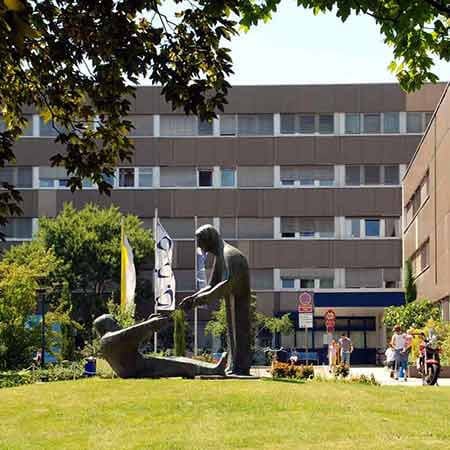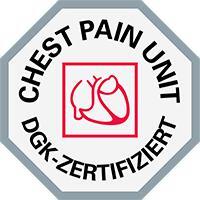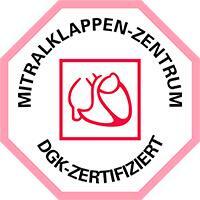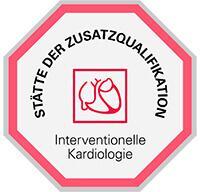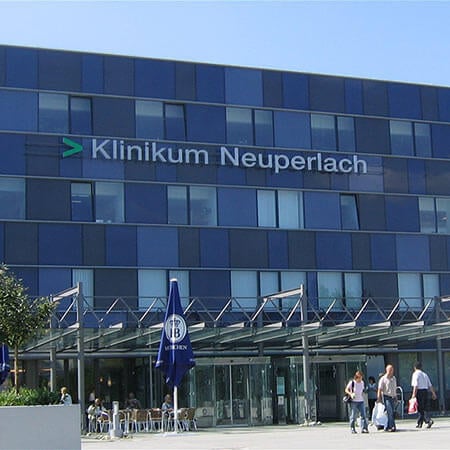The heart attack occurs because of insufficient or completely stopped blood supply to the myocardium. The most common cause of this effect is blood clots that form in the blood vessels.
Acute pain in the heart area can be absolutely sudden. Depending on the degree of localization, the human body can return to life or coronary death occurs. As a result of the pain syndrome, the heart muscles die off, which affects the further functioning of the cardiovascular system.
People of advanced age, active and passive smokers are mostly at risk. According to statistics, heart attack (myocardial infarction) most often affects men and people with a sedentary lifestyle.
Content
- Overview
- Why it occurs?
- Diagnostics in Germany
- A typical course of the heart disease
- How is myocardial infarction treated?
- Indications for surgery
- Treatment tactics in Germany
- Rehabilitation after the heart attack
- The cost of treatment in Germany
Overview
Myocardial infarction is the leading cause of death in many places in the world. In many cases, timely medical care can prevent irreversible processes, but patients often misjudge its clinical manifestation and try to manage it on their own, which results in a late visit to a doctor. Therefore, in case of alarming symptoms, it is necessary to consult a specialist as early as possible.
The probability of myocardial infarction increases with age; people over 60 are more likely to fall ill. Currently, the incidence in people under 40 years of age has increased. Men predominate among patients under the age of 70, but after 70, this parameter equalizes between sexes.
Why it occurs?
Myocardial infarction develops as a result of impaired blood supply to the heart muscle, which leads to a lack of oxygen, nutrients, and necrosis of the myocardium. The main cause of the disruption of blood flow in the vessels feeding the myocardium is atherosclerosis of the coronary arteries – the disease that implies the deposition of atherosclerotic plaques, consisting mainly of cholesterol, on the inner surface of the vessels. Then there is a proliferation of connective tissue (sclerosis) of the vessel wall and the formation of calcium deposits with further deformation and narrowing of the vessel lumen up to complete occlusion. Subsequently, atherosclerotic plaque may develop the so-called aseptic inflammation, which under the influence of provoking factors (physical activity, increased blood pressure, etc.) can lead to plaque rupture. In the area of damage, platelets accumulate, biologically active substances are released, which further increase adhesion (sticking) of blood-forming elements, and as a result, a thrombus is formed, blocking the lumen of a coronary artery. Increased blood clotting also contributes to thrombus formation. If blood flow in the vessels is not restored within the next six hours, irreversible changes occur in myocardial tissue.
Rarely, a myocardial infarction occurs in case of acute spasm or thromboembolism of pathologically unchanged coronary arteries, but this happens only in 5% of cases.
Diagnostics in Germany
Germany is a recognized world leader in the field of pathology detection. The diagnosis of heart diseases begins with a consultation and examination by the attending physician. At the first appointment, the doctor analyzes current disease history, data on previous diagnostic examinations and treatment conducted, family history, etc., and makes a plan for further diagnostic measures, which may include:
- EchoCG (real-time ultrasound examination of the heart, which allows studying the work of the heart valves, getting a general idea of the contractile activity of individual sections of the myocardium and the direction of blood flow in the heart chambers).
- ECG (including stress tests), which is the main method of investigation in heart arrhythmias, and also helps to detect cardiosclerosis, myocardial hypertrophy, and other pathologies of the heart muscle.
- Scintigraphy (radiological examination, which allows identifying pathological foci in the myocardium, which do not accumulate radioactive isotope).
- Daily monitoring.
- Angiography (examination of the condition of blood vessels).
- Spirography (determination of the functional capacity of the lungs).
- Chest X-rays, CT or MRI scans of the chest cavity.
- Laboratory tests and examinations.
Impeccably precise diagnosis in Germany is ensured by the vast experience and professionalism of German doctors, who scrupulously follow all international protocols when determining the diagnosis. All medical examinations are carried out on up-to-date equipment, using high-quality diagnostic preparations and materials.
A typical course of the heart disease
To be able to avoid the most severe complications of heart disease, it is advisable to know and remember the classic symptoms of the development of this pathology.
Such symptoms include:
- The sudden development of acute retrosternal pain, with a burning, often pressing or constricting character.
- Irradiation of pain into the pericardial area (irradiation into the left side of the chest, left arm, or under the left shoulder blade).
- Situations when the described pain sensations are accompanied by a panic attack.
It is important to remember that the slightest suspicion of myocardial infarction development should make the patient urgently contact a doctor in order to receive specialized treatment aimed at opening the narrowed, constricted (stenosed) vessel to prevent the development of extensive necrosis of cardiac tissue.
Although a heart attack is always unexpected, recognizing it is not difficult. Its symptoms cannot be confused with any other heart disease. Do not forget that a heart attack is life-threatening. Timely medical help can save a person, and its absence will lead to death. The ambulance should be called as soon as possible.
Unfortunately, sometimes heart muscle infarction develops abnormally, making it difficult to diagnose and detect early.
For example, some patients may experience the following hidden symptoms of a coronary artery narrowing problem:
- The sensation of pain in the lower jaw, left arm or even leg.
- The occurrence of pain with the addition of nausea, abdominal bloating, and vomiting.
- Some patients may simply feel shortness of breath in the absence of other symptoms.
Somewhat less frequently in the questionable seizures, symptoms similar to the manifestations of quite different conditions may occur:
- An asthmatic-type attack, with development of bronchospasm, pulmonary edema, severe dyspnea, etc.
- An attack similar to an exacerbation of pancreatitis, with nausea, copious vomiting, general weakness, the appearance of abdominal pain.
- An attack of the neurological type, with the development of neurosis, panic attack, with disorders of consciousness, vision, with the appearance of dizziness, and headaches.
The described clinical picture should also make the patient call an ambulance immediately; independent treatment in such cases is prohibited.
How is myocardial infarction treated?
In myocardial infarction, the patient needs to be hospitalized. After the crisis is over, the patient is admitted to the cardiac intensive care unit. Depending on the nature of the course of the disease, the doctor chooses the treatment tactics:
- Instrumental treatment. It is carried out from the first minutes of the patient's admission. The cardiac surgeon may recommend coronary angioplasty (restoration of a blocked vessel by inserting a special balloon and stent through a catheter, which inflates and presses the plaques to the vessel walls, thereby restoring blood flow).
- Drug therapy. It is provided in the acute period. Anticoagulants, antithrombotic agents, and B-adrenoblockers can be used. Pain syndrome is managed with analgesics and neuroleptics, with intravenous nitroglycerin.
The specialists of the German hospitals use in their work advanced methods of treatment of cardiac diseases. Cardiac surgeons perform unique operations with minimal invasion on high-tech equipment. German doctors offer patients high-quality and accurate diagnostics of various forms of coronary heart disease and other cardiovascular pathologies.
Indications for surgery
Not all patients are susceptible to conservative therapy, which very often causes many side effects and is contraindicated in several clinical cases.
In addition to drug treatment of coronary heart disease, German specialists also use highly effective surgical methods. One of them is coronary artery stenting. This method can be used not only in the planned treatment of coronary heart disease, but also in urgent cases. Indications include the following conditions:
- Acute myocardial infarction.
- Stable angina pectoris.
- Resting stenocardia.
- Stenosis in the place of a previously implanted stent.
- Asymptomatic myocardial ischemia detected by instrumental diagnostic methods.
Contraindications to stenting are the following conditions:
- Acute and chronic infectious diseases.
- Severe decompensation of the cardiovascular system.
- Disorders of the blood coagulation system.
- Chronic diseases of the urinary system in the decompensation stage.
- Chronic respiratory insufficiency.
- Diffuse atherosclerotic affection of the coronary vessels.
German specialists take an individual approach to choosing the most effective treatment method for each patient. The attending physician always evaluates all indications and contraindications, as well as possible postoperative risks and complications. The specialized German hospitals take care of the patient's comfortable hospital stay, as well as constantly monitor their general health condition and important vital signs. Therefore, the feedback on stenting in Germany is only positive.
Treatment tactics in Germany
Most German hospitals are not so much aimed at treating myocardial infarction, but rather at preventing the onset of a heart attack. For this purpose, many techniques have been developed, both drug and surgical, capable of normalizing the heart without bringing it to a critical point. The second area of work of the clinics is rehabilitation after a heart attack in Germany.
To begin with, let's talk about special measures to prevent the development of a heart attack. Most often, German doctors resort to aortocoronary bypass surgery.
Coronary artery bypass surgery has been performed in Germany for almost half a century and has saved thousands of lives. The main part of the operation is creating a bypass between the heart aorta and an artery, which isolates the blocked part of the vessel. For this purpose, so-called "shunts" are used. These are created from the thoracic artery or the femoral vein, taken from the patient himself.
It is important to remember that bypass surgery facilitates the work of the cardiovascular system, but does not stop the development of atherosclerosis, so to use this chance to the maximum, you need to radically change your way of lifestyle in terms of diet, exercising, and giving up bad habits.
Statistics show that in 50 – 70% of cases absolutely all symptoms of the disease disappear after this surgery. In 85% of cases, there is no recurrent vascular occlusion.
Rehabilitation after the heart attack
In addition to diagnostic and therapeutic measures, the treatment of heart attack in German hospitals is based on a set of rehabilitation procedures, the purpose of which is to reduce the time it takes the patient to return to everyday life. Rehabilitation after surgical methods of intervention is similar to rehabilitation therapy after non-surgical treatment of heart disease.
Heart disease itself is already a high risk for abnormal activity in the body. The slightest increase in stress risks causing unpredictable complications, and one of them at a certain point can become a heart attack. Thus, a person with heart disease and, in addition, who has had a myocardial infarction, needs a special rehabilitation program, which could not only return the ability to lead a normal life, but also minimize the possible manifestations of the consequences.
To determine a rehabilitation program after a heart attack treatment in Germany, it is necessary to have an accurate description of the heart disease itself, as well as the severity of the post-infarction condition.
There are two main ways of medical rehabilitation after a heart attack. The first option is a medical spa treatment, which is suitable for patients with different degrees of severity of heart attack. The fourth, the most severe degree, implies rehabilitation in a hospital under constant medical supervision, since there is a risk of sudden cardiac arrest. Modern hospitals for heart attack rehabilitation in Germany can boast of their excellent infrastructure: not only the most advanced equipment and experienced professionals, but also the location in the natural environment itself has a beneficial effect on the human body.
Each patient receives an individual rehabilitation program, which is developed together with his attending physician based on examinations, personal characteristics, and preferences of a recovering person. But the main emphasis in all available rehabilitation programs after a heart attack is on three main components:
- Medication support.
- Diet.
- Physical exercises.
Drug support promotes fast recovery of damaged muscles, increases the elasticity of connective tissue scars, saturates heart tissues with energy, and improves the body in general. Diet, as a rule, aims at reducing the patient's weight and eliminating from his diet all those foods that could provoke further development of the disease. Physical exercises also help to strengthen the damaged tissue, its gradual development, and preparation for new loads.
All these procedures are performed in comfortable conditions and under the supervision of a friendly medical staff. An abundance of positive emotions, psychological rehabilitation, and daily improvement of health conditions contribute to the rapid recovery of the patients with heart disease and their return to normal life.
The list of hospitals for rehabilitation and treatment in Germany is available on the Booking Health website.
The cost of treatment in Germany
Germany is considered a leader in the treatment of various types of cardiac diseases. Cardiac surgeons perform over a hundred thousand operations a year to restore the heart and vascular function, and the number of people treated after a heart attack exceeds several hundred thousand. No wonder that the number of specialized cardiology rehabilitation centers in Germany is quite large. Rehabilitation after a heart attack under the supervision of specialists is considered a very desirable phenomenon that can significantly speed up recovery and restoration of the cardiovascular system.
Both the cost of treatment in Germany and the prices for rehabilitation may vary depending on the specifics of the clinical case. Although, on average:
- The cost of treatment with angioplasty and stenting starts at 10,828 EUR.
- The cost of treatment with cardioverter-defibrillator implantation starts at 10,290 EUR.
- The cost of treatment of myocardial infarction and valve stenosis with CABG and valve replacement starts at 13,667 EUR.
- The prices for cardiac rehabilitation start at 566 EUR.
To find out the prices for specific procedures for treatment in Germany, please contact Booking Health. Booking Health strives to be useful for your health, so we have developed several programs of heart examinations and treatment, so as not to take up too much of your time and to conduct only the necessary tests and therapeutic measures.
Authors: Dr. Nadezhda Ivanisova, Dr. Sergey Pashchenko
